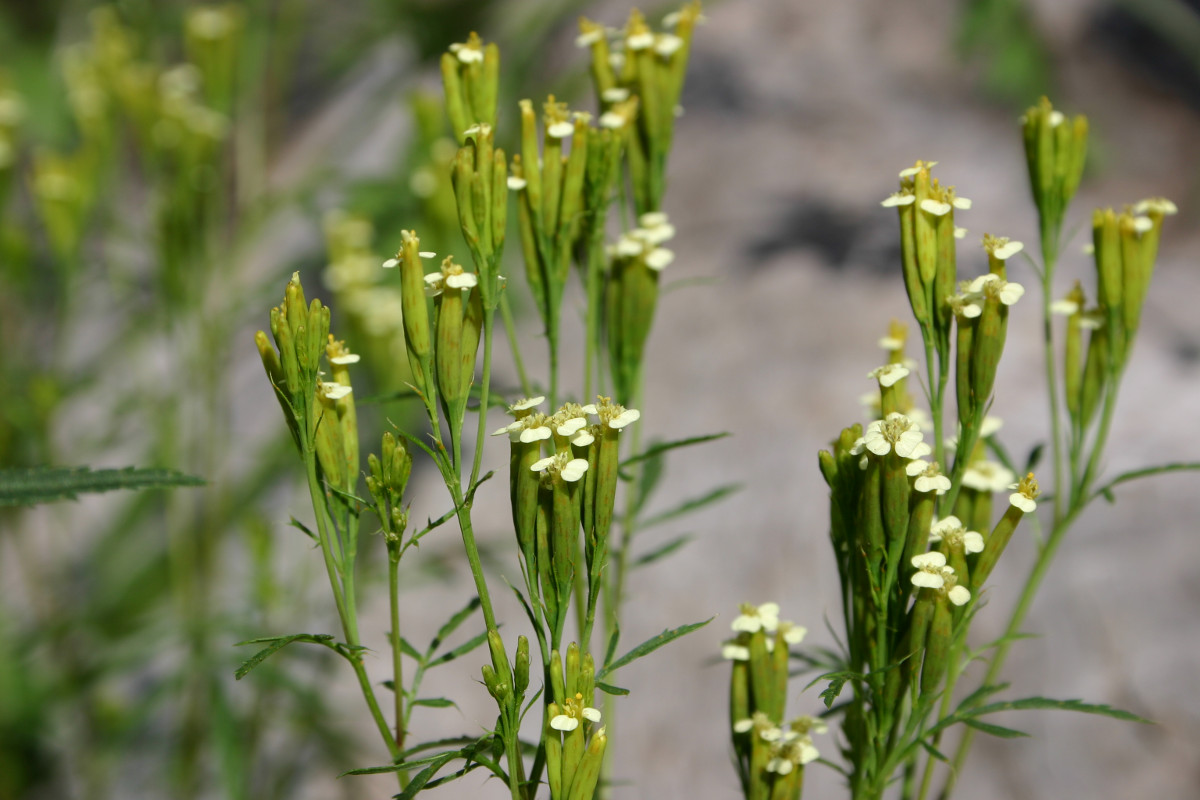Tagetes minuta L. - syn. Tagetes glandulifera Schrank - Asteraceae
huacatay (span.), southern marigold, Mexican marigold, Mexikanische Studentenblume
Annual herb, 30-100cm high, native to South America, naturalized and cultivated elsewhere; leaves lanceolate to linear; flowers tiny, yellow-white.
„It is used as a culinary herb in Peru, Ecuador, and parts of Chile and Bolivia. It is called by the Quechua terms wakatay in Peru or wakataya in Bolivia… Wakatay paste is used to make the popular Peruvian potato dish called ocopa“ http://en.wikipedia.org/wiki/Tagetes_minuta
Main components of the essential oil of flowering plants were β-ocimene (38.6%), dihydrotagetone (10.6%), tagetone (10.7%), (Z)-ocimenone (5.0%), and (E)-ocimenone (26.0%).
[Brunke, Ernst-Joachim, F. J. Hammerschmidt, and E. A. Aboutabl. „Progress in Essential oil research.“ ed. E.-J. Brunke, W. de Gruyter, Berlin (1986): 117-122]
Main components of the essential oil of the flowers were β-ocimene (31-47%) and tagetenone (ocimenone, 34-36%), furthermore dihydrotagetone (1-6%), tagetone (3-8%), limonene (4-6%) and β-phellandrene (1%).
The essential oil of the leaves contained dihydrotagetone (28-47%) as main compound. Minor components were β-ocimene (12-17%), tagetenone (8-18%), tagetone (12-18%), limonene (11-13%) and β-phellandrene (2%).
[Study of the chemical composition of Essential oils by Gas Chromatography. Chamorro, E. R., Zambón, S. N., Morales, W. G., Sequeira, A. F., Velasco, G. A., Nat. Tech University, Argentina, Vol.15, 2012, 307-324]
„The essential oil from the leaves of Tagetes minuta L., growing wild in Yemen, was obtained by hydrodistillation… Major components of the essential oil were (Z)-ocimenone (15.9%), (E)-ocimenone (34.8%), (Z)-β-ocimene (8.3%), limonene (2.3%), (Z)-tagetone (1.8%), dihydrotagetone (1.4%) and an unidentified dimethylvinylketone derivative (20.6%). The oil showed moderate cytotoxic activity against MCF-7 breast tumor cells, … and .. potent antiradical activity. Antimicrobial activity was also investigated on several microorganisms, and the essential oil exhibited high activity against methicillin-resistant Staphylococcus aureus (MRSA) with aninhibition zone of 23 mm. It also exhibited remarkable antifungal activity against Candida albicans with an inhibition zone of 26 mm.“
[Composition of Essential Oil from Targetes minuta and its Cytotoxic, Antioxidant and Antimicrobial Activities, Ali, N. A. A., Sharopov, F. S., Al-kaf, A. G., Hill, G. M., Arnold,N., Al-Sokari, S. S., Setzer, W. N., Wessjohann L., Nat Prod Commun 9, 2014, 265-268]
„The volatile oil (orange-yellow color) obtained by hydrodistillation method of the aerial parts of Tagetes minuta showed an average yield of 0.77% (according to dry material weight)… The oil profile exhibits dihydrotagetone (23.44%) as the most abundant compound. The other main compounds were spathulenol (10.56%), caryophyllene oxide (6.35%), alpha-atlantone (4.76%) and isoaromadendrene epoxide (3.11%), respectively. In fact, the essential oil tested was rich in monoterpenoids. The oil of T. minuta L. has been evaluated in some parts of the country by a number of investigators who have recognized α-terpineol (20.8%), β-ocimene (17.6%) and dihydrotageton (45.9%), trans-ocimenone (27.0%), cis-β-ocimene (11.9%) and limonene (13.0%), piperitenone (12.2%), α-terpinolene (11.0%) as the major components in this species. “
[Rezaei, F., Jamei, R., & Heidari, R. (2018). Evaluation of Volatile Profile, Fatty Acids Composition and in Vitro Bioactivity of Tagetes Minuta Growing Wild in Northern Iran. Advanced pharmaceutical bulletin, 8(1), 115-121] https://www.ncbi.nlm.nih.gov/pmc/articles/PMC5896386/

Tagetes minuta flowers, author: Paul Venter, (PD, CC0)
https://commons.wikimedia.org/wiki/File:Tagetes_minuta00_2.jpg